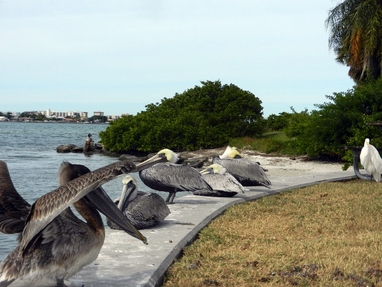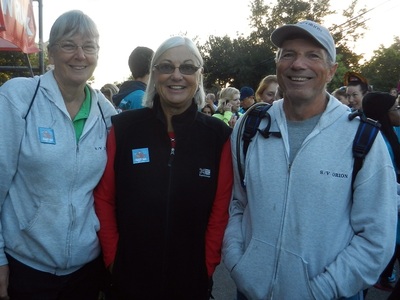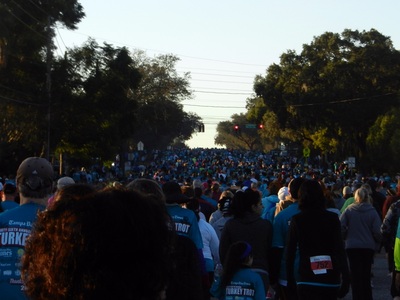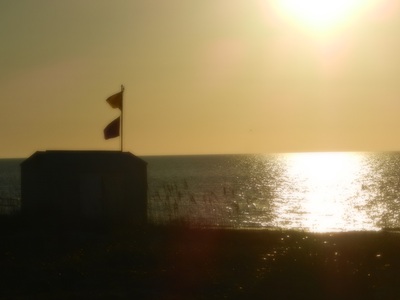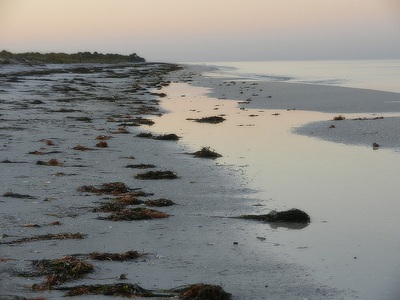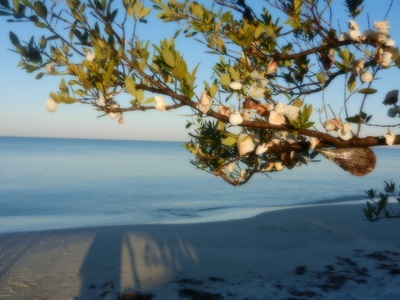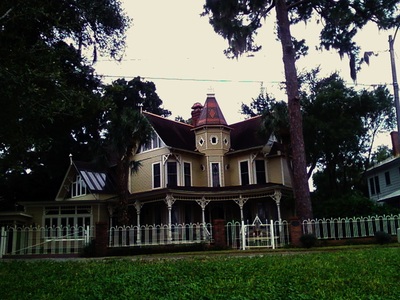
We've spent the better part of 3 weeks in Florida as we made our way across the state to the west coast to launch Orion Jr for the first time on our own. She made it into the water in Clearwater and we have since taken her north from there to Tarpon Springs. We hope to spend another few weeks in this part of the coast.
 Launching at Clearwater
Launching at Clearwater Ready to Launch
Although Orion Jr is a trailerable sailboat, we've never been able to launch her on our own. We discovered this on our way to our summer cruise on NY's Erie Canal. (Luckily, the marina there had a way to launch it for us.) There were 2 problems. First, the electric over hydraulic brakes had a battery and a brake controller mounted just behind the tongue of the trailer, neither of which was supposed to get wet. Given how deep we needed to put the trailer into the water to get her to float, these boxes were unlikely to stay dry. The other problem was our need to use the extended tongue to let the trailer go deep in the water without getting the truck tires wet. Since this tongue sits about 7 inches below the regular tongue, we needed the trailer to raise an additional 7 inches to get it on our ball mount. However, the original jack could not raise the trailer more than a couple of inches higher than the ball mount. Not nearly enough. When Dave contacted the folks at Magic Tilt, they agreed to solve both of these problems for us.
Although Orion Jr is a trailerable sailboat, we've never been able to launch her on our own. We discovered this on our way to our summer cruise on NY's Erie Canal. (Luckily, the marina there had a way to launch it for us.) There were 2 problems. First, the electric over hydraulic brakes had a battery and a brake controller mounted just behind the tongue of the trailer, neither of which was supposed to get wet. Given how deep we needed to put the trailer into the water to get her to float, these boxes were unlikely to stay dry. The other problem was our need to use the extended tongue to let the trailer go deep in the water without getting the truck tires wet. Since this tongue sits about 7 inches below the regular tongue, we needed the trailer to raise an additional 7 inches to get it on our ball mount. However, the original jack could not raise the trailer more than a couple of inches higher than the ball mount. Not nearly enough. When Dave contacted the folks at Magic Tilt, they agreed to solve both of these problems for us.
 Brake controller now raised up on the post.
Brake controller now raised up on the post. So, before we headed south, we arranged a stop in Clearwater at the Magic Tilt headquarters so they could work on the trailer. Arriving at their location on the end of a narrow, dead-end street, we were a little nervous about getting into a difficult situation. But, we were able to disconnect before getting into trouble. Graham confirmed that he planned to raise the controller up on the post that supports the bow. He would then replace the jack with one that had the range capable of mounting the extended tongue. While he had the trailer in their shop, they would also remove the extra length from the bunk supports. When we returned a couple of days later, all work was done as expected. If we managed to get the brake controller wet now, we had lots more serious problems to worry about.
 New trailer jack stand
New trailer jack stand The new jack stand was also very different to work with. It has no wheel on it, but rather a small plate that supports it. The post can be moved large distances by removing a pin and then dropping it. The last few inches of height were covered by the crank. Although the lack of a wheel means there's little side to side movement, we managed to hook up the trailer successfully without any trouble.
After picking up Orion Jr and her trailer from Magic Tilt, we made a beeline for the boat launch. It was a Thursday, and the one thing we knew for certain is that we didn't want to launch on a weekend. We had observed this same boat ramp the Sunday before and the power boaters were launching and retrieving boats in quick succession, non-stop. And Friday would count as a weekend day. Our timing was good. The combination of weather and weekday gave us an empty parking lot and 6 empty boat ramps. Right! This boat ramp also had labels on each ramp showing how much distance back the ramp extended into the water. That would allow us a comfort margin to ensure the trailer wheels didn't drop off the end.
After picking up Orion Jr and her trailer from Magic Tilt, we made a beeline for the boat launch. It was a Thursday, and the one thing we knew for certain is that we didn't want to launch on a weekend. We had observed this same boat ramp the Sunday before and the power boaters were launching and retrieving boats in quick succession, non-stop. And Friday would count as a weekend day. Our timing was good. The combination of weather and weekday gave us an empty parking lot and 6 empty boat ramps. Right! This boat ramp also had labels on each ramp showing how much distance back the ramp extended into the water. That would allow us a comfort margin to ensure the trailer wheels didn't drop off the end.
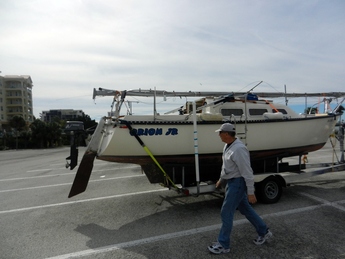 Dave checks out Orion Jr before launching
Dave checks out Orion Jr before launching We had already decided to raise the mast after launching, so we focused our preparations on the essentials to secure the boat and get it underway: mount the outboard and connect the fuel, re-mount the rudder and tiller, rig docklines and fenders, and remove the dinghy and gin pole from under the trailer. We had one new installation to do as well. Our homemade motor mount pad had delaminated over the summer, so we had to install a new factory-made one. It took less than an hour to get all of this prep done. When we were ready to move, we took off all of the straps, except the one attached to the trailer winch at the bow. We then switched to the extended tongue. Using the new jack, it connected easily. So, we were finally ready to launch.
 Dave loosens strap to release the boat from the trailer
Dave loosens strap to release the boat from the trailer We had chosen the Seminole boat ramp in Clearwater not just for its proximity to the Magic Tilt plant, but also because it had a deep dropoff, lots of open parking area. So, in the empty lot, Dave manuevered over to the longest ramp and Cathy positioned on the side of the ramp. We had really wanted to keep the truck tires out of the water to ensure they didn't run the risk of slipping. Cathy gave the signal when they were at this point and we tried to release the boat and see if it was floating enough. As Dave let out the strap and Cathy pulled on the dock line, it was obvious she wasn't going to move. So, Dave edged the trailer further back. It didn't take many inches before Jr was floating and she pulled off easily. There was a stiff breeze, and Cathy had only managed to grab a bow line, so it took a little more manuevering to get her on the dock and keep the mast away from the pilings. With her secure, Dave parked the truck and trailer. Shortly after, we had the outboard fired up and we were backing up out of the ramp. Check a big milestone off the list. With the marina around the point from the ramp, we were tied up in our slip a few minutes later. Of course that was enough time to get a 3 foot wake from a power boat. It's great to be back on the water.
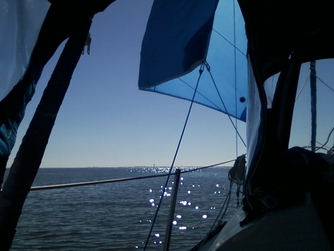 Back on the water and under sail
Back on the water and under sail Ready to Sail?
When we headed to the Erie Canal, we had completely removed the mast, so re-rigging it proved more work than it had been to take it down in the spring. We carefully followed each stay / shroud from its location on the mast to the deck fitting trying to ensure it would be untangled when the mast was in position. We had labeled each of the ends, and luckily most of the labels stayed in place and readable, although pretty badly worn from 4 months in the weather. Before we raised the mast, we had a couple of projects to take care of. Dave had fashioned a new mast top bracket to support the new anchor light and a new Windex. The Windex needed to be attached to the bracket. Then the bracket secured to the top of the mast. Once we made the first attempt, we realized we needed to change its orientation so that the Windex would clear the VHF antenna. This required it to be bent at a different angle. Once Dave made the changes, it mounted fine. After wiring the anchor light into mast wires, the installation was complete.
When we headed to the Erie Canal, we had completely removed the mast, so re-rigging it proved more work than it had been to take it down in the spring. We carefully followed each stay / shroud from its location on the mast to the deck fitting trying to ensure it would be untangled when the mast was in position. We had labeled each of the ends, and luckily most of the labels stayed in place and readable, although pretty badly worn from 4 months in the weather. Before we raised the mast, we had a couple of projects to take care of. Dave had fashioned a new mast top bracket to support the new anchor light and a new Windex. The Windex needed to be attached to the bracket. Then the bracket secured to the top of the mast. Once we made the first attempt, we realized we needed to change its orientation so that the Windex would clear the VHF antenna. This required it to be bent at a different angle. Once Dave made the changes, it mounted fine. After wiring the anchor light into mast wires, the installation was complete.
In the meantime, Cathy secured new spreader boots and replaced the cable ties on our lazy jack blocks on the spreaders. She also ran some fish lines through the lazy jack blocks to ensure we could get the lazy jacks run once we had the boom in place. With the mast projects done and the rigging secure, we now had to rig the gin pole. This would be critical to having the leverage and control to get the mast up. After a few false starts, we finally remembered all of the rigging for the pole. The biggest oops being that we initially forgot to put the spinnaker halyard on the gin pole. Note to self: This is really important. In our defense, we were into our 6th hour of work on these projects by this point without any breaks. So, we were getting a little loopy.
Once the gin pole was rigged, we secured 2 ratchet straps loosely over the mast at the deck step and at the stern in preparation for positioning the mast on its tabernacle. Once the mast started moving, it would no longer be balanced and would want to flip into the water. We wanted to avoid this possibility. With the bolt in place, securing the mast to the deck, Dave started to raise the mast with the gin pole. It worked great. We had a couple of twisted turnbuckles that we had to straighten out. The majority of the rigging was run as it should be. However, the backstay was on the wrong side of the stern rail, which it took us a bit to figure out why all the forward rigging was too tight.
Despite our fatigue, we had to keep going before we could relax. The furling system had to be installed to give the mast its forward support. The boom, stackpack and mainsail had to be installed to allow the bimini to be rigged. And we needed the bimini in place to get us out of the sun. So, the day ground on. As the sun was starting to set, we were finally getting ready to leave the boat to get some supper. The only big things left were the headsail and the solar panels. But Dave realized he hadn't tested the anchor light once it was reconnected. He quickly flipped the switched to see it light as we were about to leave.
Nothing.
We were running out of energy, but this could be a big deal. What if there was a problem inside the mast? Neither of us could even consider the possibility of lowering the mast again. And we had left the Top Climber back on Orion to save weight. Dave pulled out the multimeter and began testing the light. He became convinced that the problem was in the connections at the base of the mast. He was able rig a temporary connection to plug it into a 12V outlet and it lit. Hurray!! The problem wasn't solved, but we knew the problem was at deck level. It was time to get some dinner and call it a day.
Once the gin pole was rigged, we secured 2 ratchet straps loosely over the mast at the deck step and at the stern in preparation for positioning the mast on its tabernacle. Once the mast started moving, it would no longer be balanced and would want to flip into the water. We wanted to avoid this possibility. With the bolt in place, securing the mast to the deck, Dave started to raise the mast with the gin pole. It worked great. We had a couple of twisted turnbuckles that we had to straighten out. The majority of the rigging was run as it should be. However, the backstay was on the wrong side of the stern rail, which it took us a bit to figure out why all the forward rigging was too tight.
Despite our fatigue, we had to keep going before we could relax. The furling system had to be installed to give the mast its forward support. The boom, stackpack and mainsail had to be installed to allow the bimini to be rigged. And we needed the bimini in place to get us out of the sun. So, the day ground on. As the sun was starting to set, we were finally getting ready to leave the boat to get some supper. The only big things left were the headsail and the solar panels. But Dave realized he hadn't tested the anchor light once it was reconnected. He quickly flipped the switched to see it light as we were about to leave.
Nothing.
We were running out of energy, but this could be a big deal. What if there was a problem inside the mast? Neither of us could even consider the possibility of lowering the mast again. And we had left the Top Climber back on Orion to save weight. Dave pulled out the multimeter and began testing the light. He became convinced that the problem was in the connections at the base of the mast. He was able rig a temporary connection to plug it into a 12V outlet and it lit. Hurray!! The problem wasn't solved, but we knew the problem was at deck level. It was time to get some dinner and call it a day.
 Dave fixes the fuse holder in the outboard
Dave fixes the fuse holder in the outboard Ehe next day, Cathy was down for the count, so Dave did what he could to get the boat ready. By Sunday, Cathy was back and we were able to finish provisioning, and cleared out the V-berth so we could finally sleep there. By Monday, the winds let up enough to get the headsail rigged. We were almost done. Dave just had to wire the outboard into the batteries so the electric start would work and the batteries charge when we are running. However, even this simple task didn't go well. The engine wouldn't start despite all the connections showing power. In the process, Dave broke a fuse in the engine that we had no replacement for. That meant he had to replace the fuse holder. Even after all this work, it still didn't start. At that point, Cathy looked at the gear shift. It wasn't in neutral. Aaargh!. That was the problem all along. So, we were able to top off the water and fuel, return the truck to the storage lot and cast off the dock lines by early afternoon.
We were finally underway and for the first time in 7 months once again ready to sail.
We were finally underway and for the first time in 7 months once again ready to sail.
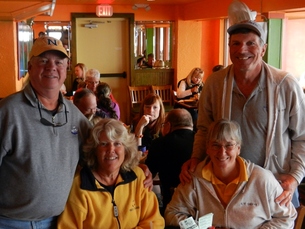
Doing What We Came For
But what's all this work for? We wanted to see new places and visit with friends – old and new. It didn't take long to have that happen. Before arriving in Clearwater, we learned that our friends Randy and Sherri on Priorities would be anchored there when we arrived. We stopped over to Clearwater Beach on a blustery Tuesday and joined them for lunch. They were on their to the Bahamas with friends, so we were not likely to see them again this trip. Our next reunion was with Val and Graham from Bonnie Lass, who were at home in Palm Harbor, which is right next door to our first port of call, Tarpon Springs. We were invited to join them for their Thanksgiving celebration, which started with the Turkey Trot in Clearwater. While Dave, Val and Cathy walked the 5K Fun Run, Graham dug in and ran the 10K. None of us got recognized as top finishers, but we felt that we earned our Thanksgiving dinner, which was delicious.
But what's all this work for? We wanted to see new places and visit with friends – old and new. It didn't take long to have that happen. Before arriving in Clearwater, we learned that our friends Randy and Sherri on Priorities would be anchored there when we arrived. We stopped over to Clearwater Beach on a blustery Tuesday and joined them for lunch. They were on their to the Bahamas with friends, so we were not likely to see them again this trip. Our next reunion was with Val and Graham from Bonnie Lass, who were at home in Palm Harbor, which is right next door to our first port of call, Tarpon Springs. We were invited to join them for their Thanksgiving celebration, which started with the Turkey Trot in Clearwater. While Dave, Val and Cathy walked the 5K Fun Run, Graham dug in and ran the 10K. None of us got recognized as top finishers, but we felt that we earned our Thanksgiving dinner, which was delicious.
 Anclote Key lighthouse outside entrance to Tarpon Springs
Anclote Key lighthouse outside entrance to Tarpon Springs Between visits, we explored some new areas. Tarpon Springs is our new "high water mark", being the furthest north we've traveled on the gulf coast. Trips further north require longer distances between ports and not much development until you get to Appalachicola on the panhandle. We'll see when we make it there. After touring the sponge docks in Tarpon, we moved back south to another of Florida's state parks, Caladesi Island. Like Cayo Costa, it is a beautiful barrier island, with a lovely beach, good shelling, and a scenic nature trail through the interior. Unlike Cayo Costa, it has some very nice, protected docks. They were inexpensive and had power and water. Pretty nice! While there, we got to know a couple that had just arrived on their Island Packet, Luna, and were settling in to be park hosts for the next few months.
So, all the work paid off, and we expect to continue to enjoy the fruits of our labors a bit before we have to haul back out later in December. More about that later.
So, all the work paid off, and we expect to continue to enjoy the fruits of our labors a bit before we have to haul back out later in December. More about that later.


